INSTRUCTION MANUAL
GUIDE D'UTILISATION
MANUAL DE INSTRUCCIONES
INSTRUCTIVO DE OPERACIÓN, CENTROS DE SERVICIO Y
PÓLIZA DE GARANTÍA. ADVERTENCIA: LÉASE ESTE
INSTRUCTIVO ANTES DE USAR EL PRODUCTO.
Questions? See us on the World Wide Web at www.dewalt.com
D28754
12" (305mm) Cut-Off Machine
Tronçonneuse de 305 mm (12 po)
Máquina cortadora de 305 mm (12 pulg.)
A
B
G
F
D
C
A. TRIGGER SWITCH
GÂCHETTE
CONMUTADOR TIPO
GATILLO
B. BRUSH DOOR
PANNEAU DES
BALAIS
COMPUERTA
DE ESCOBILLAS
C. DEPTH ADJUSTMENT
WING NUTS
ÉCROU À OREILLES
DE RÉGLAGE DE
PROFONDEUR
TUERCAS DE MARIPOSA
PARA EL AJUSTE DE
PROFUNDIDAD
D. GUARD
DISPOSITIF DE
PROTECTION
PROTECTOR
E. SHOE
PATIN
BASE
E
H
DEWALT Industrial Tool Co., 701 East Joppa Road, Baltimore, MD 21286 (MAR04 CD1)
Form No. 623540-00 D28754 Copyright © 2003, 2004
The following are trademarks for one or more DEWALT power tools: the yellow and black color scheme;
the “D” shaped air intake grill; the array of pyramids on the handgrip; the kit box configuration; and the
array of lozenge-shaped humps on the surface of the tool.
IF YOU HAVE ANY QUESTIONS OR COMMENTS ABOUT THIS OR ANY DEWALT TOOL,
CALL US TOLL FREE AT: 1-800-4-D
EWALT (1-800-433-9258)
General Safety Rules
WARNING! Read and understand all instructions. Failure to
follow all instructions listed below may result in electric shock,
fire and/or serious personal injury.
SAVE THESE INSTRUCTIONS
WORK AREA
• Keep your work area clean and well lit. Cluttered benches and dark areas invite accidents.
• Do not operate power tools in explosive atmospheres, such as in the presence of
flammable liquids, gases, or dust. Power tools create sparks which may ignite the dust or
fumes.
• Keep bystanders, children, and visitors away while operating a power tool. Distractions
can cause you to lose control.
ELECTRICAL SAFETY
• Grounded tools must be plugged into an outlet properly installed and grounded in
accordance with all codes and ordinances. Never remove the grounding prong or
modify the plug in any way. Do not use any adapter plugs. Check with a qualified
electrician if you are in doubt as to whether the outlet is properly grounded. If the tools
should electrically malfunction or break down, grounding provides a low resistance path to
carry electricity away from the user. This tool uses grounded construction (3 prong plug) to
provide a means to transfer electrical energy safely away from the user in the event the tool
electrically malfunctions, breaks down, or the tool case becomes live. Damage to, or loss of,
one of the 3 plug blades; damage to the plug or cord, or failure to have the tool plugged into a
verified and continuously grounded electrical system, may result in electric shock, serious
injury, or death. To avoid these risks of injury, the tool must, at all times, be maintained and in
proper working order (cord, plug blades) and plugged into a continuously grounded electrical
system. (See also “Cleaning” in the Maintenance section.) Applicable only to Class I
(grounded) tools.
• Double insulated tools are equipped with a polarized plug (one blade is wider than the
other.) This plug will fit in a polarized outlet only one way. If the plug does not fit fully in
the outlet, reverse the plug. If it still does not fit, contact a qualified electrician to install
a polarized outlet. Do not change the plug in any way. Double insulation eliminates the
need for the three wire grounded power cord and grounded power supply system. Applicable
only to Class II (double insulated) tools.
• Avoid body contact with grounded surfaces such as pipes, radiators, ranges and
refrigerators. There is an increased risk of electric shock if your body is grounded.
• Don’t expose power tools to rain or wet conditions. Water entering a power tool will
increase the risk of electric shock.
• Do not abuse the cord. Never use the cord to carry the tools or pull the plug from an
outlet. Keep cord away from heat, oil, sharp edges or moving parts. Replace damaged
cords immediately. Damaged cords increase the risk of electric shock.
• When operating a power tool outside, use an outdoor extension cord marked “W-A” or
“W.” These cords are rated for outdoor use and reduce the risk of electric shock. When using
an extension cord, be sure to use one heavy enough to carry the current your product will
draw. An undersized cord will cause a drop in line voltage resulting in loss of power and
overheating. The following table shows the correct size to use depending on cord length and
nameplate ampere rating. If in doubt, use the next heavier gage. The smaller the gage
number, the heavier the cord.
Minimum Gage for Cord Sets
Volts Total Length of Cord in Feet
120V 0-25 26-50 51-100 101-150
Ampere Rating
More Not more AWG
Than Than
12 - 16 14 12 Not Recommended
PERSONAL SAFETY
• Stay alert, watch what you are doing and use common sense when operating a power
tool. Do not use tool while tired or under the influence of drugs, alcohol, or medication.
A moment of inattention while operating power tools may result in serious personal injury,
• Dress properly. Do not wear loose clothing or jewelry. Contain long hair. Keep your hair,
clothing, and gloves away from moving parts. Loose clothing, jewelry, or long hair can be
caught in moving parts. Air vents often cover moving parts and should also be avoided.
• Avoid accidental starting. Be sure switch is off before plugging in. Carrying tools with
your finger on the switch or plugging in tools that have the switch on invites accidents.
• Remove adjusting keys or wrenches before turning the tool on. A wrench or key that is
left attached to a rotating part of the tool may result in personal injury.
• Do not overreach. Keep proper footing and balance at all times. Proper footing and
balance enables better control of the tool in unexpected situations.
• Use safety equipment. Always wear eye protection. Dust mask, non-skid safety shoes,
hard hat, or hearing protection must be used for appropriate conditions.
TOOL USE AND CARE
• Use clamps or other practical way to secure and support the workpiece to a stable
platform. Holding the work by hand or against your body is unstable and may lead to loss of
control.
• Do not force tool. Use the correct tool for your application. The correct tool will do the job
better and safer at the rate for which it is designed.
• Do not use tool if switch does not turn it on or off. Any tool that cannot be controlled with
the switch is dangerous and must be repaired.
• Disconnect the plug from the power source before making any adjustments, changing
accessories, or storing the tool. Such preventative safety measures reduce the risk of
starting the tool accidentally.
• Store idle tools out of reach of children and other untrained persons. Tools are
dangerous in the hands of untrained users.
• Maintain tools with care. Keep cutting tools sharp and clean. Properly maintained tools,
with sharp cutting edges are less likely to bind and are easier to control.
• Check for misalignment or binding of moving parts, breakage of parts, and any other
condition that may affect the tools operation. If damaged, have the tool serviced before
using. Many accidents are caused by poorly maintained tools.
• Use only accessories that are recommended by the manufacturer for your model.
Accessories that may be suitable for one tool, may become hazardous when used on another
tool.
SERVICE
• Tool service must be performed only by qualified repair personnel. Service or
maintenance performed by unqualified personnel could result in a risk of injury.
• When servicing a tool, use only identical replacement parts. Follow instructions in the
Maintenance section of this manual. Use of unauthorized parts or failure to follow
Maintenance Instructions may create a risk of electric shock or injury.
Additional Specific Safety Instructions for Cut-Off
Machines
• Always use proper guard with grinding wheel. A guard protects operator from broken
wheel fragments and wheel contact.
• Accessories must be rated for at least the speed recommended on the tool warning
label. Wheels and other accessories running over rated speed can fly apart and cause
injury. Accessory ratings must always be above tool speed as shown on tool nameplate.
• Hold tool by insulated gripping surfaces when performing an operation where the
cutting tool may contact hidden wiring or its own cord. Contact with a “live” wire will
make exposed metal parts of the tool “live” and shock the operator.
• ALWAYS WEAR EYE PROTECTION WHEN USING THIS TOOL.
• Use of accessories not specified in this manual is not recommended and may be
hazardous. Use of power boosters that would cause the tool to be driven at speeds greater
than its rated speed constitutes misuse.
• Do not use circular saw blades or any other toothed blades with this tool. Serious
injury may result.
• Before using, inspect recommended accessory for cracks or flaws. If such a crack or
flaw is evident, discard the accessory. The accessory should also be inspected
whenever you think the tool may have been dropped. Flaws may cause wheel break-
age. Do not set unit down on wheel.
• When starting the tool with a new or replacement wheel installed, or if you are unsure
of the condition of the wheel, hold the tool in a well protected area and let it run for
one minute. If the wheel has an undetected crack or flaw, it should burst in less than one
minute. Never start the tool with a person in line with the wheel. This includes the operator.
• Avoid bouncing the wheel or giving it rough treatment. If this occurs, stop the tool and
inspect the wheel for cracks or flaws.
• Direct sparks away from operator, bystanders or flammable materials. Sparks may be
produced while using a sander or grinder. Sparks may cause burns or start fires.
• Always use bail handle. Tighten the handle securely. The bail handle should always be
used to maintain control of the tool at all times.
• Never cut into area that may contain electrical wiring or piping. Serious injury may
result.
• Clean out your tool often, especially after heavy use. Dust and grit containing metal par-
ticles often accumulate on interior surfaces and could create an electric shock hazard.
• Do not operate this tool for long periods of time. Vibration caused by tool action may be
harmful to your hands and arms. Use gloves to provide extra cushion and limit exposure by
taking frequent rest periods.
WARNING: Some dust created by power sanding, sawing, grinding, drilling, and other con-
struction activities contains chemicals known to cause cancer, birth defects or other reproduc-
tive harm. Some examples of these chemicals are:
• lead from lead-based paints,
• crystalline silica from bricks and cement and other masonry products, and
• arsenic and chromium from chemically-treated lumber (CCA).
Your risk from these exposures varies, depending on how often you do this type of work. To
reduce your exposure to these chemicals: work in a well ventilated area, and work with
approved safety equipment, such as those dust masks that are specially designed to filter out
microscopic particles.
F. BAIL HANDLE
POIGNÉE DE MANOEUVRE
ASA
G. FIELD CASE
BOÎTIER
CAJA PROTECTORA DEL
MOTOR
H. TRIGGER SWITCH HANDLE
POIGNÉE DE LA GÂCHETTE
MANGO DEL CONMUTADOR
TIPO GATILLO
FIG. 1

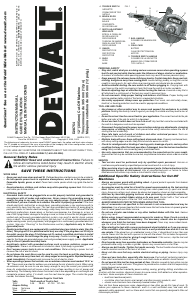


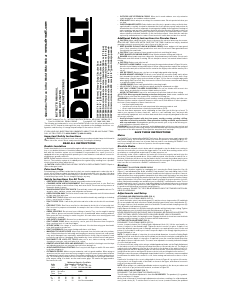
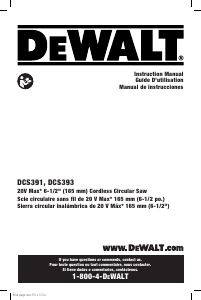
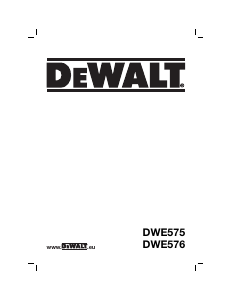
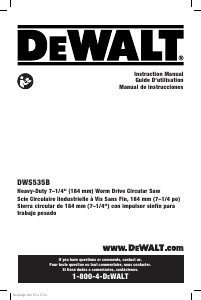
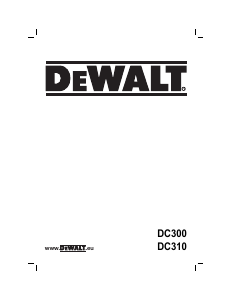



Joignez-vous à la conversation sur ce produit
Ici, vous pouvez partager ce que vous pensez du DeWalt D28754 Scie circulaire. Si vous avez une question, lisez d’abord attentivement le mode d’emploi. La demande d’un mode d’emploi peut être effectuée en utilisant notre formulaire de contact.